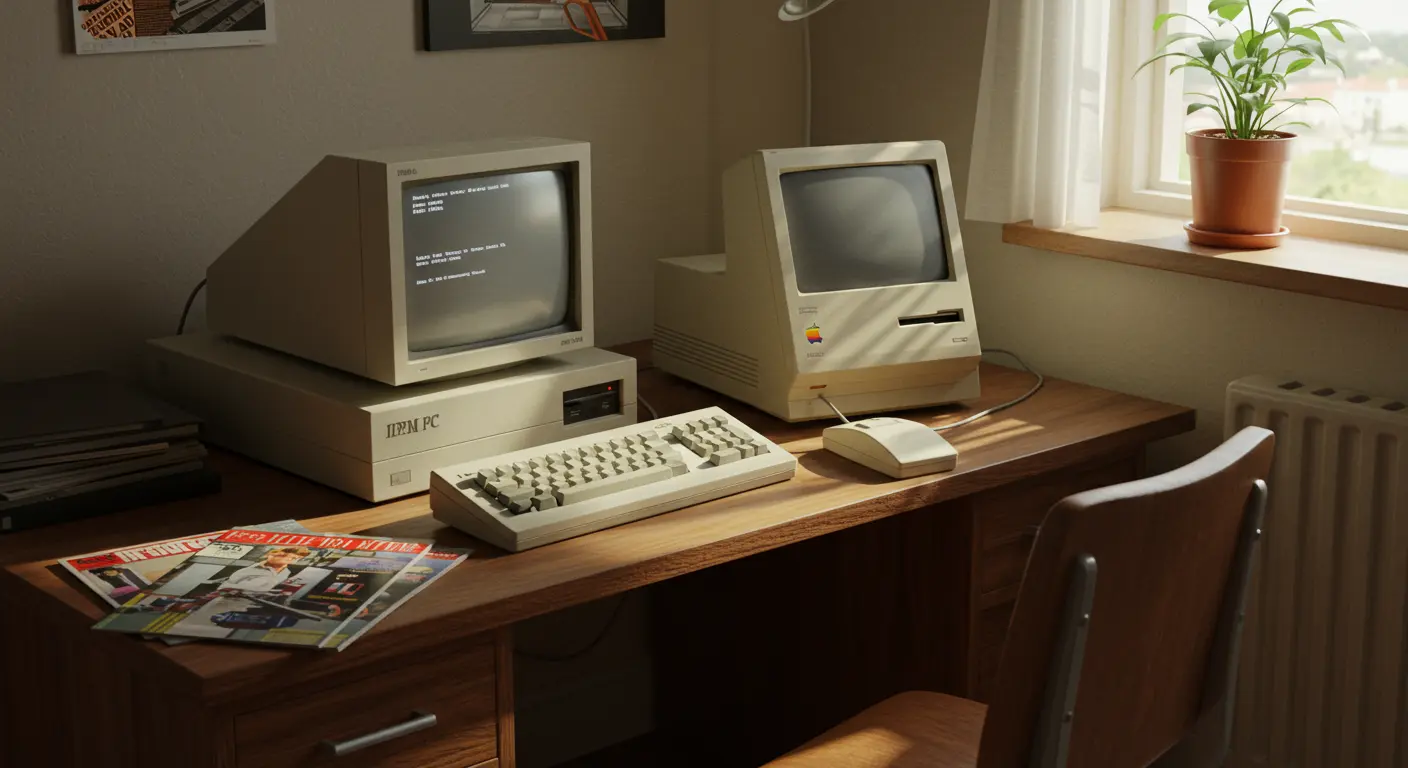Exploring the Most Influential Inventions of the 1980s
The Rise of Personal Computers – IBM and Apple
The 1980s marked a pivotal moment when personal computers transformed from exclusive corporate tools into accessible household companions. Two industry titans spearheaded this transformation: IBM’s groundbreaking 5150 (the IBM PC) debuted in 1981, establishing new computing standards, while Apple’s visionary Macintosh arrived in 1984, introducing an intuitive graphical interface that welcomed non-technical users into the digital age. These machines introduced more than new technology—they created the foundation for our modern digital world.
These early personal computers marked a dramatic change from the room-sized, prohibitively expensive mainframes that had previously monopolized computing power. IBM and Apple created more than new products; they made technology accessible to everyone. By delivering computing power directly to individuals’ desks at relatively affordable prices, they ignited a digital literacy movement that would define the coming decades. The philosophical battle between these computing giants—IBM’s open, business-centric approach versus Apple’s closed yet elegantly user-friendly ecosystem—continues to shape our technological landscape today.
IBM-PC – Revolutionizing Home Computing
When IBM unveiled its Personal Computer in August 1981, it launched more than a product—it changed computing forever. Priced at $1,565, the PC’s revolutionary open architecture became its defining feature, allowing third-party manufacturers to create compatible hardware and establishing what would become known as the ‘PC standard.’
This open architecture strategy proved brilliant, spurring explosive growth in the PC market as companies like Compaq began producing cheaper IBM-compatible machines. The standardization also catalyzed a software development boom, giving birth to influential business applications like Lotus 1-2-3 and Word-perfect. The IBM PC’s impact goes well beyond sales numbers—it established the technical and business foundation that would dominate computing for decades, with its architectural DNA still influencing modern PCs today.
Apple Macintosh – User-Friendly Innovation
On January 24, 1984, Apple launched more than a computer—it changed personal computing forever with the Macintosh, dramatically unveiled in an iconic Super Bowl advertisement. The Mac represented a radical departure from the era’s dominant text-based interfaces, featuring an intuitive graphical user interface complete with icons, windows, and a revolutionary pointing device: the mouse. This point-and-click approach transformed computing from a technical skill into an accessible tool, liberating users from memorizing complex command sequences.
The Macintosh’s influence transcended its modest sales figures. Its core philosophy—that computers should be intuitive and genuinely enjoyable to use—established new industry standards for human-computer interaction. While the GUI concept originated at Xerox PARC, Apple masterfully refined and commercialized it for mass consumption. The Mac’s emphasis on typography and visual aesthetics also sparked the desktop publishing revolution. Despite its steep initial price of $2,495, the Mac’s user-friendly approach ultimately made computers an indispensable tool worldwide.
Medical Innovations – Advancements in Healthcare
The 1980s brought remarkable medical breakthroughs that fundamentally transformed healthcare and saved countless lives. This decade’s innovations tackled some of medicine’s most pressing challenges—from heart disease and infectious illnesses to mental health disorders. These advances improved patient outcomes and created new approaches for medical research and treatment that continue to influence healthcare today.
Key medical innovations of the decade included:
-
The Artificial Heart: Offered hope to patients with terminal cardiac conditions, often serving as a bridge to transplants.
-
The Hepatitis-B Vaccine (1980): Dramatically reduced infection rates of the serious liver disease.
-
Prozac (1987): Revolutionized psychiatric care with a more targeted approach to treating depression.
These breakthroughs demonstrated how technology could address both physical and mental health challenges and set new standards for patient care.
Artificial Heart – A Breakthrough in Medicine
December 2, 1982, marked a pivotal moment in medical history when Dr. William Decries performed the first permanent artificial heart implantation, giving dentist Barney Clark—who was dying from congestive heart failure—a second chance at life through the Jarvik-7 device. Developed by Dr. Robert Jarvis, this mechanical marvel mimicked a natural heart’s pumping action. Though originally conceived as a permanent solution, the Jarvik-7 ultimately proved most valuable as bridge technology, sustaining patients while they awaited heart transplants.
This achievement represented the culmination of research spanning back to the 1950s. Although Clark survived only 112 days, the Jarvik-7 definitively proved that mechanical circulatory support was not just theoretically possible—it was clinically viable. This breakthrough inspired a new generation of cardiac devices. Today’s sophisticated ventricular assist devices (Ads) and total artificial hearts are direct descendants of this pioneering technology, marking it as a true landmark in medical engineering.
Prozac – Transforming Mental Health Treatment
When the FDA approved Prozac (fluoxetine) in December 1987, it introduced more than another antidepressant—it changed psychiatric care and fundamentally altered public understanding of depression. As the first widely available selective serotonin reuptake inhibitor (SSRI), Prozac marked a major advance over older antidepressants, which often plagued patients with debilitating side effects. Prozac’s precisely targeted mechanism offered genuine relief to millions by selectively modulating serotonin levels in the brain while minimizing adverse effects.
Prozac transcended medicine to become a cultural phenomenon, attracting over 4.5 million American users within just five years. Its cultural impact proved as significant as its clinical benefits, sparking nationwide conversations that helped dismantle the stigma surrounding mental health treatment. Despite ongoing controversies over side effects and potential overprescription, Prozac fundamentally transformed mental healthcare and paved the way for an entire family of SSRIs. Perhaps most importantly, it helped establish depression’s biological basis, shifting medical understanding toward a more comprehensive biopsychosocial model of mental illness.
Consumer Electronics – Gadgets that Changed Lives
The 1980s brought a consumer electronics revolution that fundamentally transformed everyday life by bringing cutting-edge digital technology into personal spaces. This decade became synonymous with the miniaturization and personalization of technology, as devices evolved to become more portable, affordable, and refreshingly user-friendly. These innovations changed how people experienced entertainment and media, creating cultural patterns that continue to shape our digital lives today.
Three of the most influential consumer electronics of the decade were:
-
The Sony Walkman: Liberated music from home stereos, creating the first personal listening experience.
-
The Compact Disc (CD) Player: Introduced digital audio quality to consumers, beginning the shift from analog formats.
-
Disposable Cameras: Democratized photography by making it cheap and accessible without technical knowledge.
These devices represented a fundamental shift in personal technology, establishing consumer expectations for convenience and portability that continue to drive innovation today.
Walkman – The Birth of Portable Music
When Sony introduced the Walkman TPS-L2 in 1979, reaching global markets throughout the early 1980s, it fundamentally transformed humanity’s relationship with music. This remarkably compact, 14-ounce cassette player liberated music from the confines of home and car stereos, creating the world’s first truly personal, mobile listening experience. Its lightweight, battery-powered design empowered individuals to carry their favorite soundtracks anywhere while maintaining perfect courtesy to others around them.
The Walkman’s cultural impact was truly revolutionary, essentially creating the concept of personal soundtracks for daily life. With over 200 million units sold, it established portable music as an essential component of modern existence. Technically superior to portable record players—cassettes never skipped—the Walkman introduced thoughtful innovations like dual headphone jacks for sharing music and a clever ‘hotline’ button for quick conversations. Most significantly, the Walkman forged an intimate, personal relationship with music that directly paved the way for CD players, MP3 devices, and today’s smartphones.
Disposable Cameras – Making Photography Accessible
In 1986, Fuji film’s ingeniously named Utsurun-Desk (‘It Takes Pictures’) became the first truly successful disposable camera, effectively democratizing photography for the masses. This brilliantly simple, inexpensive device made picture-taking accessible to millions without requiring the substantial cost or technical expertise that traditional cameras demanded. The genius lay in its simplicity: cameras came preloaded with film, and after use, the entire unit was returned to processors for development.
The disposable camera’s impact was profoundly cultural rather than merely technical, transforming photography from a serious, equipment-heavy hobby into a spontaneous, casual activity. It revolutionized tourism by enabling travelers to document their adventures without risking valuable equipment. These cameras became ubiquitous fixtures at parties and weddings, perfect for capturing candid, unguarded moments. While digital technology eventually rendered them obsolete, disposable cameras created the crucial cultural expectation that anyone could effortlessly capture life’s precious moments—a democratizing trend that digital photography would later complete.
Gaming Innovations – The Birth of Modern Gaming
The 1980s represented the formative era of modern video gaming, a transformative decade during which the industry not only recovered from the devastating 1983 crash but also laid the foundational stones for today’s interactive entertainment empire. Gaming evolved dramatically from the simple arcade experiences of the 1970s into sophisticated entertainment forms featuring compelling narratives and immersive virtual worlds. These innovations transformed video games from a niche hobby into a mainstream, billion-dollar cultural force.
Two Nintendo products were particularly revolutionary:
-
Nintendo Entertainment System (NEW): Released in North America in 1985, it revitalized the home console market with high-quality games and reliable hardware.
-
Game Boy (1989): Created the first successful portable gaming platform, allowing sophisticated games to be played anywhere.
These devices established new paradigms for game design and business models, proving that video games could be complex entertainment experiences with lasting cultural significance.
Nintendo Entertainment System – Home Gaming Revolution
When Nintendo released the NEW in North America in 1985, the gaming industry was still reeling from the catastrophic 1983 market crash, with retailers deeply skeptical of low-quality games flooding the market. Nintendo’s revitalization strategy proved revolutionary: they repositioned the NEW as an ‘entertainment system,’ complete with innovative peripherals like R.O.B. the robot, strategically distinguishing it from previous failed consoles. Most crucially, Nintendo implemented rigorous quality control, requiring all games to earn their coveted ‘Seal of Quality.’
The NEW’s impact on gaming and popular culture was immense:
-
Iconic Franchises: It introduced enduring series like Super Mario Bros., The Legend of Zelda, and Metro id, which established new genres.
-
Business Model: It pioneered third-party licensing with strict quality control, a model that stabilized the industry.
-
Market Success: With over 61 million units sold, it proved home gaming was a sustainable, mainstream medium.
-
Hardware Standard: Its controller, with a directional pad and A/B buttons, became the template for future game pads.
-
Cultural Legacy: It created a generation of gamers, cementing video games as a central part of popular culture.
Game Boy – Portable Gaming Experience
Released in April 1989, Nintendo’s Game Boy represented a handheld revolution that fundamentally transformed when, where, and how people experienced video games. Created by the visionary Junta Yoko, it succeeded where countless competitors had failed by achieving the perfect balance of capability, battery life, durability, and an accessible $89.99 price point that welcomed a remarkably broad audience into portable gaming.
The Game Boy’s phenomenal success was cemented by its killer application: Tetris, which came bundled with the console and appealed to demographics far beyond traditional gamers. Selling over 118 million units worldwide, its influence proved immense and lasting. It established portable gaming as a distinct entertainment category, requiring games specifically designed for short, satisfying sessions. Revolutionary features like the Link Cable enabled the first mainstream portable multiplayer experiences. The Game Boy’s enduring legacy is clearly visible in Nintendo’s subsequent handhelds and today’s massive mobile gaming industry.
Cultural Impact of 80s Inventions – Shaping Society
The technological innovations of the 1980s did more than introduce new gadgets—they reshaped how people interacted with each other, consumed media, and understood their evolving place in an increasingly connected society. This pivotal decade marked the birth of our modern digital culture, creating entirely new behaviors, expectations, and social patterns that continue to evolve and influence our daily lives.
The cultural impact of 1980s technology was multifaceted, shifting society from analog to digital paradigms:
-
Personal Computers (IBM & Apple): Democratized access to information by bringing computing power into homes and small businesses.
-
Gaming Systems (NEW): Created shared cultural experiences and references that spanned generations.
-
Portable Devices (Walkman & Game Boy): Established expectations for personal, mobile technology that led to the modern smartphone.
-
Media Innovations (MTV): Transformed how music was marketed and consumed, deeply influencing youth identity.
The cultural DNA of today’s hyperconnected world can be traced directly to these transformative inventions.
MTV – Redefining Music and Culture
When MTV launched on August 1, 1981, with The Buggies’ prophetic ‘Video Killed the Radio Star,’ it ignited a Cultural Revolution that would forever transform music and youth culture. As television’s first 24-hour music video channel, MTV radically shifted how music was promoted, consumed, and experienced. Previously, artists existed primarily as voices; MTV made the visual component of music equally important as the audio, transforming music videos into essential marketing tools and artistic statements.
MTV’s influence extended far beyond music:
-
Fashion and Trends: It became a powerful arbiter of youth fashion, with viewers emulating artists like Madonna and Michael Jackson, accelerating global trends.
-
Identity Formation: It provided a constant stream of visual and musical references that helped young people construct their identities.
-
Racial Dynamics: After initial criticism, the success of artists like Michael Jackson helped diversify mainstream music and break down racial barriers.
-
Media Legacy: By making visual storytelling central to music, MTV created a template for multimedia entertainment that influences advertising and social media today.







